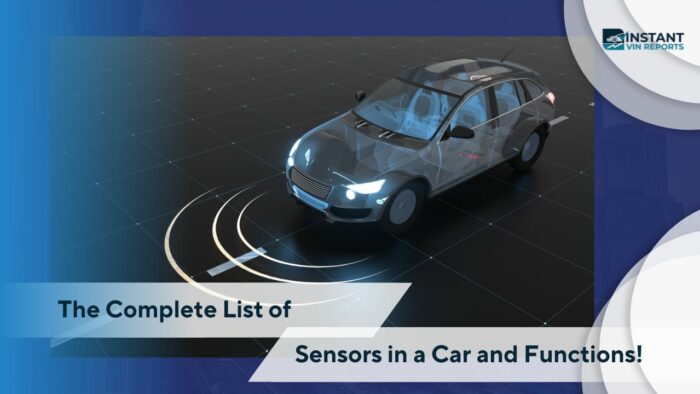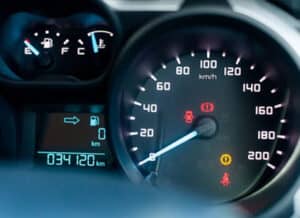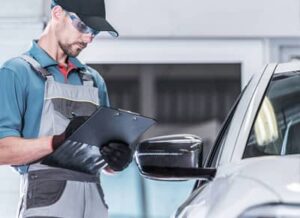Modern vehicles rely heavily on sensors for various purposes, such as safety, performance, efficiency, intelligent features, monitoring, comfort, and control.
As sensor technology advances, it is revolutionizing the automotive industry, paving the way for safer and more efficient self-driving cars; this is evident in new self-driving cars utilizing the LIDAR system.
With smaller and smarter sensors, automotive sector innovation is inevitable, promising safer, more efficient, and eco-friendly vehicles.
You may wonder how many sensors are in a car. While the number can vary, typically, there are between 15 and 30 sensors in the engine alone and over 70 sensors spread throughout the vehicle.
DID YOU KNOW?
The automotive sensor market is experiencing significant growth, with a Compound Annual Growth Rate (CAGR) of around 10.1%. This signifies a rising demand for sensors in vehicles.
READ ALSO: Car Trim: Definitions, Examples, and Finding Yours
What are Car Sensors?
Car sensors are small electronic devices embedded throughout a vehicle. They function like the car’s nervous system, continuously monitoring engine health, environmental conditions, and passenger safety. These sensors gather data, convert it into electrical signals, and send the information to the Electronic Control Unit (ECU), the vehicle’s main computer. The ECU uses this data to adjust various aspects of the car, from fuel injection to climate control.
Car Sensors and Their Functions
Car sensors play a crucial role in vehicle performance and safety. They detect physical or chemical changes, such as temperature, pressure, or oxygen levels, and relay the information to the ECU.
- Sensing: They identify changes like temperature and oxygen levels.
- Data Transmission: Sensors convert measurements into electrical signals.
- Informing the ECU: The data tells the ECU, which adjusts vehicle functions automatically.
List of Car Sensors Based on Their Location
The table below gives a detailed explanation of what each of the car sensors does according to their names. This is the most comprehensive list you can find on the internet for now; keep in mind that as technology advances, the number of sensors in a car might increase or decrease.
Sensors in the Engine Bay
The engine bay is full of components that are crucial to the car’s performance and functionality. That’s why it’s jam-packed with sensors to ensure that the components can communicate with each other and function properly.
There are three primary categories of sensors in the engine bay based on their functions.
Engine and Performance control
| Sensor | Function |
| Throttle Position Sensor (TPS) | Tracks the position of the throttle valve to regulate fuel injection and enhance engine performance. |
| Mass Airflow Sensor (MAF) | Determines the mass flow rate of air entering the engine to calculate the correct amount of fuel needed. |
| Manifold Absolute Pressure (MAP) Sensor | Gauges the pressure inside the intake manifold to assess engine load and fine-tune fuel delivery. |
| Camshaft Position Sensor (CMP) | Identifies the position of the camshaft to synchronize fuel injection and ignition timing. |
| Knock Sensor | Detects engine knock (pre-ignition) to modify ignition timing and prevent engine damage. |
| Turbo Boost Pressure Sensor | Assesses the pressure of intake air in turbocharged engines to maximize performance. |
| Turbocharger Speed Sensor | Measures turbocharger speed to fine-tune boost pressure and engine performance. |
| Exhaust Valve Position Sensor | Tracks the position of exhaust valves in performance exhaust systems for peak engine performance and sound. |
| Fuel Composition Sensor | Analyzes fuel composition to optimize delivery and control emissions. |
Emission Control
| Sensor | Function |
| Throttle Position Sensor (TPS) | Tracks the position of the throttle valve to regulate fuel injection and enhance engine performance. |
| Mass Airflow Sensor (MAF) | Determines the mass flow rate of air entering the engine to calculate the correct amount of fuel needed. |
| Manifold Absolute Pressure (MAP) Sensor | Gauges the pressure inside the intake manifold to assess engine load and fine-tune fuel delivery. |
| Camshaft Position Sensor (CMP) | Identifies the position of the camshaft to synchronize fuel injection and ignition timing. |
| Knock Sensor | Detects engine knock (pre-ignition) to modify ignition timing and prevent engine damage. |
| Turbo Boost Pressure Sensor | Assesses the pressure of intake air in turbocharged engines to maximize performance. |
| Turbocharger Speed Sensor | Measures turbocharger speed to fine-tune boost pressure and engine performance. |
| Exhaust Valve Position Sensor | Tracks the position of exhaust valves in performance exhaust systems for peak engine performance and sound. |
| Fuel Composition Sensor | Analyzes fuel composition to optimize delivery and control emissions. |
Temperature and Pressure Monitoring
| Sensor | Function |
| Engine Coolant Temperature (ECT) Sensor | Keeps an eye on the engine coolant temperature to prevent overheating and ensure an optimal fuel mixture. |
| Intake Air Temperature (IAT) Sensor | Records the temperature of the intake air to calibrate fuel delivery and ignition timing. |
| Oil Temperature Sensor | Tracks the temperature of the engine oil to optimize performance and longevity. |
| Battery Temperature Sensor | Keeps the battery temperature in check to prevent overheating and optimize charging. |
| Fuel Pressure Sensor | Keeps track of the fuel pressure in the system for optimal delivery. |
| Oil Pressure Sensor | Monitors the oil pressure in the engine to alert the driver of low levels. |
| Ambient Temperature Sensor | Records the outside temperature to manage climate control systems and display the external temperature on the dashboard. |
| Battery Voltage Sensor | Monitors battery voltage to assess health and charging status. |
Sensors Inside the Car’s Cabin
Here are the tables breaking down the sensors inside the car cabin, categorized by their functionality.
Climate Control Sensors
The sensors below help to control the temperature inside the cabin of a car. They play important parts in keeping you cool or warm depending on the weather outside.
| Sensor | Function |
| Cabin Temperature Sensor | Keeps track of the inside temperature to maintain comfortable climate conditions for passengers. |
| Humidity Sensor | Detects the level of humidity inside the car and adjusts the climate control for optimal comfort. |
| Ambient Temperature Sensor | Records the outside temperature, helping to regulate the climate control system and display accurate outside temperatures. |
Safety and Security Sensors
The safety and security sensors are mostly in charge of making sure that you’re operating the vehicle within its limits. They also alert you of things that may cause harm or accidents, like whether the door is closed properly.
| Sensor | Function |
| Seat Occupancy Sensors | Detects if seats are occupied to ensure airbags deploy appropriately for passenger safety. |
| Door Position Sensors | Identifies whether doors are open or closed, activating interior lights and warning systems accordingly. |
| Window Position Sensors | Determines the position of power windows to control their operation and prevent obstructions. |
| Sunroof Position Sensor | Monitors the position of the sunroof to control its operation and prevent it from being obstructed. |
| Hood Open Sensor | Alerts the driver if the hood is not securely closed by detecting its position. |
| Trunk Open Sensor | Detects if the trunk or tailgate is open or closed, alerting the driver if it is not securely closed. |
| Immobilizer Sensor | Ensures the presence of a valid key or key fob, allowing the engine to start and preventing theft. |
| Key Fob Sensor | Communicates with the vehicle’s security system for remote locking, unlocking, and engine starting functions. |
| Anti-theft Alarm Sensors | Detects unauthorized entry or tampering, triggering the vehicle’s alarm system. |
| Remote Start Sensors | Interfaces with the vehicle’s remote start system to start the engine from a distance. |
| Occupant Detection Sensors | Identifies the presence of occupants in the vehicle to manage airbag deployment and seatbelt reminders. |
| Collision Detection Sensors | Senses potential collisions and activates safety systems like airbags and seat belt pre-tensioners. |
| Driver Monitoring System Sensors | Keeps an eye on driver behavior and alertness to prevent accidents and enhance safety. |
| Blind Spot Monitoring System (BSM) Sensors | Spots vehicles in blind spots and warns the driver to prevent collisions during lane changes. |
| Lane Departure Warning System (LDWS) Sensors | Detects lane markings and alerts the driver if the vehicle drifts out of its lane. |
| Adaptive Cruise Control (ACC) Sensors | Tracks the distance to the vehicle ahead and adjusts vehicle speed accordingly. |
| Parking Sensors | Detects obstacles around the vehicle, assisting with parking maneuvers. |
| Reverse Camera Sensors | Helps the driver see the rear surroundings while reversing. |
| Light Sensors | Measures ambient light levels to automatically control headlights and interior lighting. |
| Rain Sensor | Detects rain on the windshield and activates the wipers automatically. |
Performance and Driving Assistance Sensors
These sensors mainly help to translate the drivers’ input into the engine and steering system. They also measure things like tire pressure, suspension height, etc.
| Sensor | Function |
| Vehicle Speed Sensor (VSS) | Provides data on the vehicle’s speed for systems like the speedometer, cruise control, and ABS. |
| Steering Angle Sensor (SAS) | Tracks the steering wheel’s angle for stability control and other safety systems. |
| Yaw Rate Sensor | Measures rotation around the vehicle’s vertical axis to help with stability control and rollover prevention. |
| Acceleration Sensors | Records acceleration forces on the vehicle for stability control and airbag deployment. |
| Brake Fluid Level Sensor | Alerts the driver of low brake fluid levels by monitoring the reservoir. |
| Brake Pad Wear Sensor | Notifies the driver when brake pads are worn and need replacement. |
| Tire Pressure Monitoring System (TPMS) Sensors | Keeps an eye on tire pressure and alerts the driver of low pressure to ensure safety and fuel efficiency. |
| Start-Stop System Sensors | Detects when the vehicle is stationary and automatically shuts off the engine to conserve fuel. |
| Suspension Height Sensors | Measures the height of the vehicle’s suspension to adjust ride height and maintain stability. |
| Adaptive Damping Control Sensors | Monitors road conditions and vehicle dynamics to adjust suspension damping for optimal comfort and handling. |
| Adaptive Headlight Control Sensors | Adjusts the direction and intensity of headlights based on vehicle speed and steering input for improved visibility. |
Infotainment and Convenience Sensors
These sensors are not always present, but in cars that have infotainment and convenient features, they usually play a crucial role in operating them.
| Sensor | Function |
| Gesture Control Sensors | Detects hand gestures to control infotainment and other vehicle systems without physical contact. |
| Voice Recognition Sensors | Listens to voice commands to operate infotainment, navigation, and other vehicle systems. |
| Microphone Array | Captures audio for hands-free calling, voice commands, and other audio-based features. |
| GPS Receiver | Receives satellite signals to provide precise location data for navigation systems and location-based services. |
| Gyroscope Sensor | Measures orientation and rotation to support stability control and rollover prevention systems. |
| Magnetometer Sensor | Reads magnetic fields to provide compass readings and assist with navigation systems. |
| Barometric Pressure Sensor | Gauges atmospheric pressure to aid navigation systems and altitude measurements. |
Sensors in the Transmission Area
The transmission area is basically the gearbox (and its extended parts) of a car. There are a lot of moving parts inside the transmission area, which is why having these sensors is necessary.
| Sensor | Function |
| Transmission Fluid Temperature Sensor | Measures the temperature of the transmission fluid to prevent overheating and ensure smooth shifting. |
| Transmission Shift Position Sensor | Monitors the position of the gear selector to control transmission shifting and prevent gear engagement errors. |
READ ALSO: How to Find Transmission by VIN Number
Why Do Cars Have So Many Sensors?
Modern vehicles have sensors to ensure optimal performance, safety, and comfort. The ECU processes the data these sensors collect, allowing the car to make real-time adjustments–from managing fuel efficiency to activating safety features like automatic braking or lane departure alerts.
Importance of Car Sensors
Sensors are in a car for reasons. Here are few key importance:
- Enhanced Safety: Sensors monitor potential hazards and activate safety systems.
- Improved Performance: Real-time data helps optimize engine and transmission functions.
- Increased Fuel Efficiency: Sensors adjust the air-fuel mixture to reduce fuel consumption.
- Comfort and Convenience: Climate control and infotainment sensors improve passenger experience.
Limitations of Car Sensors
While sensors are in a car for good reasons, they may be diffucult to manage due to:
- Costly Repairs: Sensor malfunctions can be expensive to diagnose and fix.
- Complexity: More sensors mean a higher chance of electronic failures.
- Sensor Vulnerability: Damage from water or debris can lead to faulty readings.
- Compatibility Issues: Not all sensors work uniformly across different car models.
The evolution of car sensors has significantly improved vehicle safety, efficiency, and comfort. However, as technology advances, the complexity of these systems also increases. When buying a used car, be cautious about potential sensor issues, especially in vehicles exposed to flood damage. A vehicle history report can help identify past problems.
How Many O2 Sensors Does a Car Have?
Closing Thoughts
This list covers some of the most common car sensors and their functions. Not all cars will have these sensors; some vehicles may have additional sensors depending on their features and technology.
In recent years, my car buyers have been opting for pre-owned vehicles. Some of these used cars might have been severely damaged by floods. Damage done to sensors is not easily or quickly detected compared to the damage done to a vehicle’s body.
If you are looking to purchase a used vehicle, consider getting a vehicle history report, this will clearly show if there is any reported flood damage, accident to the car. These can make the sensors in the car to malfunction, thereby leading to frustration and costly repair.
Curious about looking up a car’s full details? Simply get the window sticker by VIN to view specifications, options, packages, safety features, mechanical features (interior and exterior) and more.
Frequently Asked Questions
How many sensors does a car have?
Modern cars can have over 70 sensors, depending on the model and features.
Do all types of cars have sensors?
Yes, all modern vehicles have sensors, though the number and types may vary based on the car’s features.
What happens if the oxygen sensor is not working correctly?
A faulty oxygen sensor can lead to poor fuel economy and increased emissions. It may also trigger the check engine light.
How do I know if a sensor in my car needs to be replaced?
Signs of a failing sensor include warning lights, poor engine performance, and erratic readings.
How much does it cost to replace a sensor in a car?
The cost varies, ranging from $50 to $500, depending on the sensor type and labor.
Can I replace a sensor in my car myself?
Some sensors, like the mass airflow sensor, are easy to replace, while others may require professional assistance.
Do all cars have the same sensors?
No, sensor types and numbers differ based on the car model, manufacturer, and specific features.










